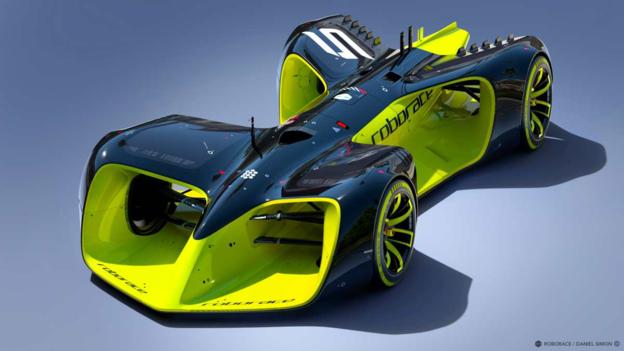The driverless race car is coming. That's a car that drives around a track. Very fast. Without a driver. Competing against other fast cars. Also without drivers. Try to contain your excitement.
Back in the 1920s, the "sport" of tether-car racing became the rage. In this pursuit, petrol-powered cars no bigger than a man's shoe raced around a circular track, each anchored to a central post by a control line. There was no human control of steering or speed — the cars simply howled around at full throttle, held in orbit by a tether. To follow the action, spectators had to spin around, giving the cars their familiar name: spindizzies.
The hobby, which was doubtless more enjoyable for the cars' builders than for those who actually showed up to witness the races, managed to enjoy a solid 30 years of popularity, finally fading from public view during the 1950s — coincidentally around the time Nascar racing came onto the American scene, presenting real humans driving untethered cars on actual tracks. (In fairness, tether-car racing still exists as a kind of fringy armchair motorsport, alongside "professional" slot-car and RC-car racing.)
Ultimately, the problem with spindizzies was that they were just machines, and any human influence on their success or failure happened in private, on a workbench the night before, rather than on a racetrack in real time. Humans tend to cheer for the success of — and fear for the safety of — other humans; a mechanical failure or wreck on the spindizzy track was likely an unemotional event for all but the failed cars' builders.
It's not difficult to imagine the autonomous racing cars of the 21st Century inspiring the same sort of indifference. It's machine versus machine, algorithm versus algorithm. Following a driverless series promises to have all the excitement of watching two guys argue over the technical superiority of their respective mobile phones. There'll be no Juan Manuel Fangios or Dale Earnhardts in the Roboracer series, no Colin McRaes or Shirley Muldowneys. Just hardware and software buzzing and bleeping against hardware and software.
That said, there's no denying that Daniel Simon's design for the Robocar, pictured here, is staggeringly cool. And really, Mr Simon knows how to push our buttons. His portfolio includes rather excellent vehicle designs from some big-budget films, including Tron: Legacy (2010), Captain America: The First Avenger (2010) and Oblivion (2013).
So what would make the Roborace series irresistible? In a word, weapons. If the wild success of Anki Drive robot toy race cars has proved anything, it's that clever weaponry (even virtual armament, à la the Anki system), with a human finger on the trigger, ups the interest factor exponentially. Watching driverless cars zip around a track, using algorithms to hit each apex with mathematical precision and a phalanx of sensors to avoid collisions, has all the thrill of speed-testing a broadband connection. But add a breathless quest for survival to the mix and watch things get interesting.
The Roboracer series, sans weaponry, is set to kick off late this year as a sideshow event for human-controlled Formula E races. Each race will last about an hour and the field of 20 driverless cars will be mechanically identical, though each of the 10 teams will be allowed to tweak and tune its cars' autonomous-drive software. That's what your IT department calls "system optimization."
(BBC)
www.ann.az
Follow us !











